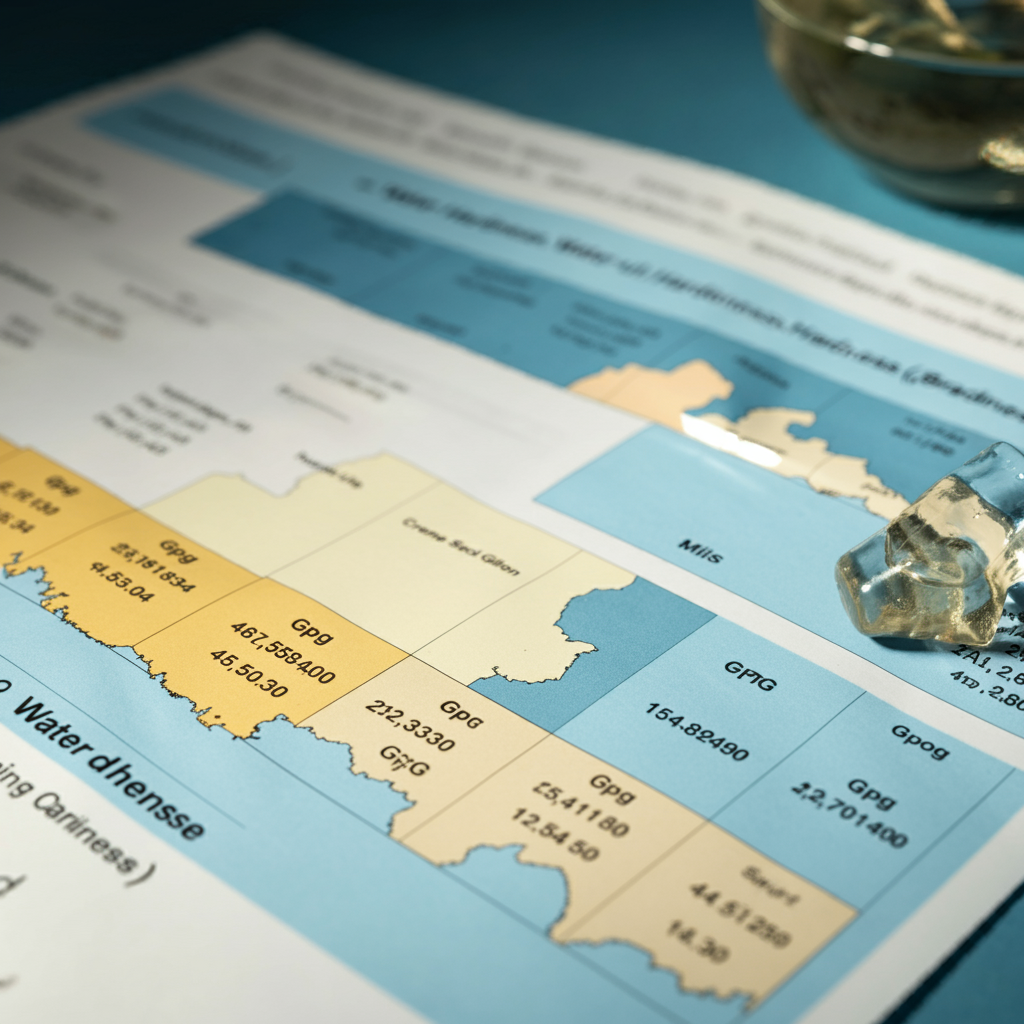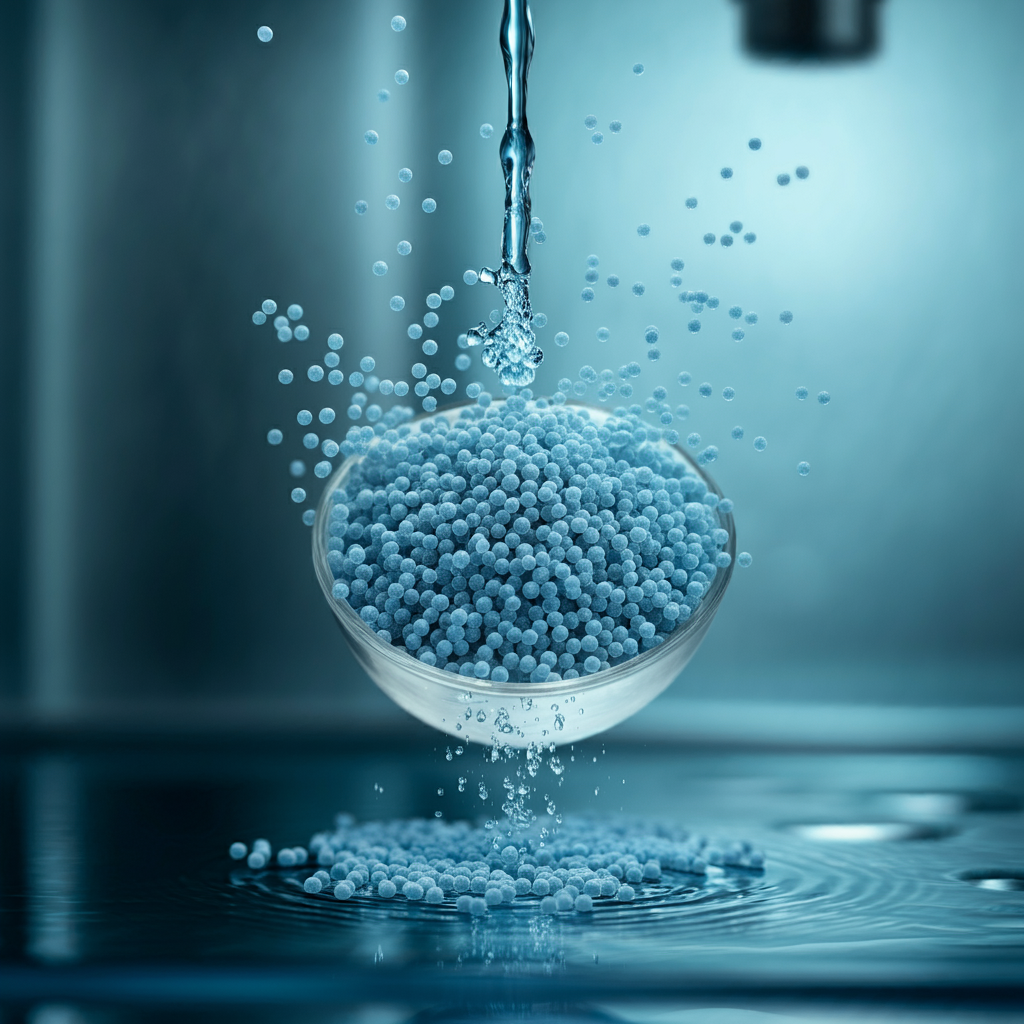Choosing the correct size for your water softener is a critical step in ensuring soft, mineral-free water throughout your home or business. Several factors influence this decision, primarily water hardness, daily water usage, peak flow rate, and the number of people in your household. Each of these elements plays a significant role in determining the capacity and regeneration frequency needed for your specific situation.
Water hardness, the concentration of minerals like calcium and magnesium in your water, directly dictates the workload of your softener. Higher hardness levels require a larger capacity or more frequent regeneration cycles to effectively remove these minerals. Your daily water consumption, influenced by household size and habits, determines the amount of water the softener needs to treat. Peak flow rate, the maximum amount of water used simultaneously, ensures the softener can handle high-demand periods without compromising water softness.
At WaterSoftenerSizing.com, we understand that navigating these factors can be overwhelming. That’s why we offer expert guidance and personalized recommendations to help you find the perfect water softener size. Just as a tailor crafts a suit to fit perfectly, we ensure your water softener is tailored to your unique needs, providing you with the optimal balance of efficiency, performance, and cost-effectiveness.
Unlike other water treatment devices like filters that mainly remove sediment and chlorine, a water softener specifically targets and removes hardness minerals through a process called ion exchange. By investing in the right size water softener, you’re not just purchasing a product; you’re investing in the long-term health of your plumbing, appliances, and the overall comfort of your home.
Why Does Water Softener Sizing Matter?
Choosing the correct size for your water softener is not merely a matter of preference; it’s a crucial decision that directly impacts the effectiveness and efficiency of your water treatment system. An improperly sized unit can lead to a range of issues, negating the very benefits you seek from soft water.
Hard Water’s Impact: More Than Just an Inconvenience
Hard water, while safe to drink, can create a host of problems in your home. The high mineral content, primarily calcium and magnesium, leaves behind a scaly residue that builds up on faucets, showerheads, and inside pipes and appliances. This buildup, known as scale, not only looks unsightly but also reduces water flow, clogs pipes, and damages appliances over time.
In the bathroom, hard water can leave your skin feeling dry and itchy and your hair dull and lifeless. Soap doesn’t lather as well, leaving behind a filmy residue that’s difficult to rinse off. In the kitchen, dishes and glassware may come out of the dishwasher spotted and cloudy.
The impact of hard water extends beyond aesthetics and inconvenience. Scale buildup in your water heater can reduce its efficiency by up to 40%, leading to increased energy consumption and higher utility bills. It can also damage the heating element, requiring costly repairs or premature replacement. Similarly, scale buildup in washing machines and dishwashers can shorten their lifespan and lead to malfunctions.
Soft Water’s Benefits: A Transformative Experience
A properly sized water softener eliminates these hard water woes, transforming your water and enhancing your daily life. Soft water lathers easily, leaving your skin feeling soft and hydrated and your hair looking shiny and manageable. Clothes laundered in soft water feel softer and look brighter, while dishes and glassware sparkle without spots or streaks.
But the benefits extend beyond the surface. Soft water helps appliances run more efficiently, potentially extending their lifespan and saving you money on repairs and replacements. It also reduces soap and detergent usage, as you won’t need as much to create a lather. With less soap scum to clean, you’ll spend less time scrubbing and more time enjoying your home.
In essence, a properly sized water softener is an investment in your home’s comfort, efficiency, and longevity. It’s about more than just enjoying softer water; it’s about protecting your plumbing, appliances, and your wallet.
Key Factors Influencing Water Softener Size
Choosing the right water softener involves understanding the interplay of several key factors. At WaterSoftenerSizing.com, we believe in empowering you with knowledge so you can make informed decisions about your water treatment system. Let’s dive into the details of these factors:
Water Hardness: The Bedrock of Sizing
Water hardness is the cornerstone of water softener sizing. It refers to the concentration of dissolved minerals, primarily calcium and magnesium, in your water supply. These minerals are harmless to ingest but can cause numerous problems in your home, as we discussed earlier.
Water hardness is typically measured in grains per gallon (GPG) or milligrams per liter (mg/L). The higher the number, the harder your water is. Understanding your water’s hardness level is essential because it directly dictates the size and capacity of the water softener you’ll need.
Testing Your Water: The First Step
Fortunately, determining your water hardness is straightforward. Your local water utility often includes this information in your water bill or publishes it in annual water quality reports. If you have a private well, you can purchase a home test kit or send a sample to a certified laboratory like those accredited by the Water Quality Association (WQA) for accurate analysis.
How Hardness Affects Sizing: A Direct Relationship
The relationship between water hardness and softener size is simple: the harder your water, the larger the softener you’ll need. This is because a larger unit has more resin beads, the media responsible for removing hardness minerals.
For example, if your water hardness measures 10 GPG, you’ll need a softener with a higher capacity than someone with 5 GPG hardness. A higher capacity softener will be able to treat more water before needing regeneration, ensuring a consistent supply of soft water even in areas with very hard water.
Remember, choosing a softener based solely on price or brand without considering your water hardness is a recipe for disappointment. An undersized unit will struggle to keep up with the demand, resulting in hard water breakthroughs and the associated problems.
Daily Water Usage: Measuring Your Needs
While water hardness sets the stage, your household’s daily water consumption is equally crucial in determining the right water softener size. The more water you use, the more work your softener needs to do, and the larger its capacity should be.
Estimating Usage: A Simple Calculation
Estimating your daily water usage involves considering the number of people in your household and their water-consuming habits. A general rule of thumb is to allocate 75 gallons of water per person per day. However, this is just an average, and your actual usage may vary.
For a more accurate estimate, consider the following factors:
- Number of bathrooms: More bathrooms typically mean more showers and baths, increasing water usage.
- Shower vs. bath frequency: Showers generally use less water than baths.
- Laundry habits: How often do you do laundry, and what size loads do you wash?
- Dishwasher usage: How often do you run the dishwasher?
- Outdoor water use: Do you water your lawn or garden regularly? Do you have a swimming pool?
By adding up the estimated water usage for each person and activity, you can get a fairly accurate idea of your household’s daily water consumption. For example, a family of four with two bathrooms, regular showers, and daily laundry might use around 300 gallons of water per day.
The Link to Softener Size: Capacity and Regeneration
Your daily water usage directly influences the softener’s capacity, measured in grains. The capacity represents the amount of hardness the softener can remove before needing regeneration. A higher capacity is necessary for households with high water usage to avoid running out of soft water and experiencing hard water issues.
For instance, if your household uses 300 gallons of water per day and your water hardness is 10 GPG, you’ll need a softener with a capacity of at least 3,000 grains (300 gallons x 10 GPG). However, to ensure optimal performance and account for occasional peak usage, it’s generally recommended to choose a softener with a slightly higher capacity than your daily requirement.
The frequency of regeneration is also intertwined with water usage. A smaller softener will regenerate more frequently to keep up with demand, while a larger softener can go longer between regenerations. Your water usage will help determine the ideal balance between softener size and regeneration frequency.
Peak Flow Rate: Meeting High Demand
While understanding your average daily water usage is crucial, equally important is factoring in your peak flow rate. This represents the maximum amount of water your household uses simultaneously, typically during busy mornings or evenings when multiple people are showering, washing dishes, or doing laundry.
What is Peak Flow Rate?
Peak flow rate is the rate at which water flows through your plumbing system at any given moment. It’s measured in gallons per minute (GPM). Every plumbing fixture and appliance has a specific flow rate, and these flow rates add up when multiple devices are used simultaneously.
For example, a standard showerhead might have a flow rate of 2.5 GPM, while a washing machine could use 4 GPM. If both are running simultaneously, your peak flow rate would be 6.5 GPM.
Estimating Peak Flow: A Practical Approach
Calculating your exact peak flow rate can be complex, as it involves considering the flow rates of all your fixtures and appliances and the probability of them being used at the same time. However, you can get a reasonable estimate by considering the following:
- Number of bathrooms: Each bathroom typically has a shower, sink, and toilet, each with its own flow rate. The more bathrooms you have, the higher your potential peak flow rate.
- Water-using appliances: Consider appliances like dishwashers, washing machines, and water softeners themselves, which can contribute significantly to peak flow.
- Simultaneous usage: Think about how many people in your household typically use water at the same time and for what activities. For example, a family with multiple teenagers might have a higher peak flow rate during the morning rush.
Why Peak Flow Rate Matters for Sizing
Your water softener must be able to handle your peak flow rate to ensure a continuous supply of soft water throughout your home. An undersized softener may struggle to keep up with demand during peak times, resulting in hard water bypassing the system and causing issues.
For example, if your estimated peak flow rate is 10 GPG and your softener can only handle 8 GPM, you might experience hard water during peak usage. Therefore, it’s crucial to choose a softener with a flow rate capacity that matches or exceeds your estimated peak flow.
Household Size: A Useful Starting Point
While not a direct factor like water hardness or usage, household size plays an indirect role in water softener sizing. Larger households generally use more water, which in turn requires a larger softener to meet the increased demand.
However, household size is just a starting point. Individual water usage habits can vary significantly, so it’s essential to consider those as well. For instance, a two-person household where both individuals take long showers and frequently run the dishwasher will likely need a larger softener than a four-person household where water usage is more conservative.
Additional Factors to Consider for Precise Sizing
While water hardness, daily usage, and peak flow rate are the primary drivers of water softener sizing, several other factors warrant consideration for a truly tailored solution. At WaterSoftenerSizing.com, we believe in a holistic approach that accounts for all the nuances of your water and lifestyle.
Type of Water Softener: Salt-Based vs. Salt-Free
The type of water softener you choose can influence the required size. Salt-based softeners are the most common and use sodium chloride (salt) to regenerate the resin beads that remove hardness minerals. They typically have larger capacities than salt-free softeners, which use alternative technologies like potassium chloride or template-assisted crystallization (TAC) to condition water without removing minerals.
- Salt-Based Softeners: If you have very hard water or a large household with high water usage, a salt-based softener with its higher capacity might be the best choice.
- Salt-Free Softeners: These are suitable for smaller households with moderate water hardness or those who prefer to avoid adding sodium to their water. Keep in mind that salt-free softeners don’t remove hardness minerals, but rather change their form to prevent scale buildup.
Regeneration Frequency: Finding the Right Rhythm
Water softeners don’t work indefinitely. They need to regenerate periodically to flush out the accumulated hardness minerals and recharge the resin beads with sodium ions (in the case of salt-based systems). The frequency of regeneration depends on several factors, including:
- Softener Capacity: A larger capacity softener can go longer between regenerations because it has more resin to absorb minerals.
- Water Hardness: Harder water will require more frequent regeneration than softer water.
- Water Usage: Higher water usage will deplete the softener’s capacity faster, necessitating more frequent regeneration.
The ideal regeneration frequency strikes a balance between efficiency and convenience. Too frequent regeneration wastes water and salt, while infrequent regeneration may lead to hard water breakthroughs. A properly sized softener will regenerate at an appropriate interval, ensuring a consistent supply of soft water without unnecessary wastage.
Iron and Manganese Content: Addressing Additional Challenges
While water softeners primarily target calcium and magnesium, other minerals like iron and manganese can also be present in your water supply. These minerals can stain fixtures and clothing and even interfere with the softener’s operation.
If your water contains high levels of iron or manganese, a standard water softener may not be sufficient. You might need a specialized softener designed to handle these minerals or additional filtration systems to remove them before the water enters the softener.
Ignoring iron and manganese can lead to clogged resin beds, reduced softener efficiency, and even premature failure. Therefore, it’s crucial to test your water for these minerals and choose a system that can effectively address them alongside hardness.
At WaterSoftenerSizing.com, we can help you identify the specific challenges in your water and recommend the most appropriate solutions, whether it’s a specialized softener, a combination of systems, or additional filtration.
How to Choose the Right Size Water Softener
Now that we understand the key factors influencing water softener sizing, let’s explore how to translate this knowledge into choosing the perfect unit for your home or business. At WaterSoftenerSizing.com, we believe that informed decision-making is key to a successful water softening experience.
Professional Consultation: The Gold Standard
The most accurate and reliable way to determine the right water softener size is to consult with a qualified professional. Plumbers and water treatment specialists, like those certified by the Water Quality Association (WQA), have the expertise and tools to assess your specific needs.
They can perform a comprehensive water analysis to determine not only the hardness level but also other factors like iron and manganese content, pH levels, and total dissolved solids (TDS). Armed with this information, they can recommend the ideal softener size and type for your unique situation.
Online Sizing Calculators: A Helpful Tool
While professional consultation is the gold standard, online sizing calculators can offer a convenient starting point. Several reputable brands, such as SoftPro, Kinetico, EcoWater Systems, and Culligan, offer calculators on their websites.
These calculators typically ask for information like your water hardness, household size, daily water usage, and peak flow rate. By inputting your data, you can get an estimated softener size range. However, keep in mind that these are just estimates and may not account for all the nuances of your water and usage patterns.
General Sizing Chart: A Quick Reference
For a quick reference, you can consult a general sizing chart that provides recommendations based on water hardness and daily water usage. These charts are readily available online and in water softener brochures. However, they should be used as a guideline rather than a definitive answer.
The Importance of Oversizing: Planning for the Future
It’s generally recommended to slightly oversize your water softener, typically by 10-20%, to accommodate fluctuations in water usage, occasional peak demands, and potential future needs like an expanding family or increased water consumption.
For example, if your calculations suggest a 32,000-grain softener, you might opt for a 40,000-grain unit for added flexibility. Oversizing ensures that your softener can handle unexpected spikes in demand and won’t be overwhelmed as your needs evolve.
Manufacturer Recommendations: Valuable Insights
Water softener manufacturers often provide sizing recommendations for their specific models. These recommendations are based on the unit’s design, capacity, and regeneration capabilities. Be sure to consult the manufacturer’s guidelines when choosing a softener to ensure it aligns with your needs.
Our Expertise at WaterSoftenerSizing.com: Your Partner in Softening
At WaterSoftenerSizing.com, we’re dedicated to helping you navigate the complexities of water softener sizing. Our team of water treatment experts can provide accurate sizing calculations, personalized recommendations, and connect you with reputable manufacturers and installers.
We understand that every home and business is unique, and we’re committed to finding the perfect water softening solution for you. Contact us today to experience the difference of soft water and enjoy a more comfortable, efficient, and cost-effective lifestyle.
Your Path to Perfectly Sized Water Softening
Choosing the right water softener size is a crucial step in ensuring your home or business enjoys the full benefits of soft water. By understanding the interplay of key factors like water hardness, daily usage, peak flow rate, household size, and additional considerations like softener type and mineral content, you can confidently select a system that meets your unique needs.
Remember, a properly sized water softener is an investment that pays off in multiple ways. It protects your plumbing and appliances, extends their lifespan, reduces energy consumption, lowers soap and detergent usage, and enhances your overall comfort and well-being. Don’t leave this important decision to chance.
Key Takeaways:
- Water hardness is the foundation of sizing: The harder your water, the larger the softener you need.
- Daily water usage drives capacity: The more water you use, the higher the softener’s capacity should be.
- Peak flow rate ensures continuous soft water: Your softener must handle peak demand to avoid hard water breakthroughs.
- Household size offers a starting point: Larger households generally need larger softeners, but individual habits also matter.
- Additional factors refine your choice: Consider softener type, regeneration frequency, and the presence of iron or manganese in your water.
- Professional guidance is invaluable: Consult a plumber or water treatment specialist for personalized recommendations.
Your Next Steps to Soft Water Bliss
Are you ready to transform your water and your life? At WaterSoftenerSizing.com, we’re here to help you every step of the way. Use our free online calculator for a preliminary size estimate, explore our comprehensive resources to learn more about water softening, or contact our team of experts for personalized assistance.
Don’t settle for hard water woes. Take control of your water quality and experience the difference a perfectly sized water softener can make!

Craig “The Water Guy” Phillips is the founder of Quality Water Treatment (QWT) and creator of SoftPro Water Systems.
With over 30 years of experience, Craig has transformed the water treatment industry through his commitment to honest solutions, innovative technology, and customer education.
Known for rejecting high-pressure sales tactics in favor of a consultative approach, Craig leads a family-owned business that serves thousands of households nationwide.
Craig continues to drive innovation in water treatment while maintaining his mission of “transforming water for the betterment of humanity” through transparent pricing, comprehensive customer support, and genuine expertise.
When not developing new water treatment solutions, Craig creates educational content to help homeowners make informed decisions about their water quality.




